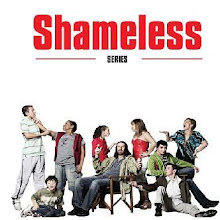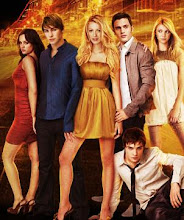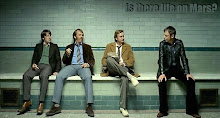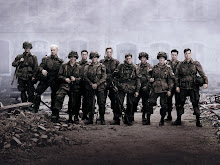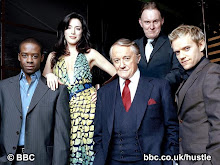A couple wake up and go downstairs to breakfast. They do not realise they are being watched by terrorists. As the couple leave for work the terrorists grab them, throw them in the back of a van and tell them to put on the blindfolds provided. The terrorist hits the girl when she protests and she hits her head and is knocked out, leaving her husband with the terrorist who is holding a gun to his head. They arrive at a house in an unknown location. A stranger passing by hears the girls screams, calls the police and eventually, after coming very close to being killed, the police rescue the man and the woman.
I have used Todorov's narrative pattern with the equilibrium - disruption - equilibrium, Levi-Strauss' theory of binary opposites, the couple as the good and the terrorists as the evil, and Propp's character roles, as the terrorists as the villains, the girl as the damsel in distress and the Police and the husband as the hero.
Why do most stories have a happy ending?
Most stories have a happy ending as it indicates the end of the story, without this the audience would be left wondering what happened and would not feel satisfied with the ending. They are usually happy as we like to believe that everything has a happy ending in real life.
The spooks opening is a standard way of beginning a narrative because it starts with the equilibrium, the normal everyday morning waking up for work, which is suddenly disrupted, by the presence of the terrorists. It also a standard beginning as it is something that the audience can relate to, an everyday morning.
Yes this narrative uses binary opposition with the characters of good and bad, the couple and the terrorists, and also between the norm and the disruption, which can also be seen as the norm being good and the disruption as being bad. The audience are led to pick a side as the empathise with the good characters as the can imagine themselves being in that situation as they see the couple as normal people like them. Another binary opposite could be safety and danger, as terrorists are associated with danger.
Single Drama/film: Margeret
These tend to have Todorov's narrative structure, equilibrium – disruption – equilibrium during every episode/film and would have many binary opposites throughout.
Two nighter: Trial & Retribution
These also have the same narrative pattern of equilibrium – disruption – equilibrium but instead it is spread out over two episodes, usually with a cliffhanger at the end of the first episode to make the audience want to watch the next episode. Most binary opposites would be made clear in the first episode.
Soap: Eastenders
These don't really start with an equilibrium because we are mostly introduced to a character when there is a disruption and the end equilibrium, if there is one as a lot of storylines don't end happily, does not happen till a lot later on, taking weeks to resolve. The binary are always present with more being introduced as different characters join/leave.
Serial: Bleak House
This is similar to soap except that the equilibrium usually comes at the end of the series, or the end of the series could be left on a cliffhanger.
Anthology Series: Skins
This type of series uses the narrative pattern equilibrium – disruption – equilibrium mostly in each episode but also with an underlying storyline across the series which eventually gets resolved in the last episode. The binary opposites are introduced in the first episode but more may be introduced in different episodes.
Long – form Series Drama: Lost
This is the same as an anthology series as there is usually an underlying narrative which carries on throughout the series, also with different narratives in single episodes which can take about two or three episodes to resolve. The binary opposites are introduced as the story unfolds.
Long – Form Series Drama with Some Narrative Experimentation: 24
Again with this form of drama the narrative pattern it spread across the series, with the the disruption being resolved at the end. There are also smaller disruptions throughout the series which can get resolved in an episode or over a few. The binary opposites tend to be introduced at the start.
Sunday, March 8, 2009
Wednesday, February 18, 2009
Waterloo road, S 4 Ep 7
Sound
Synopsis: Rachel is shocked when Eddie and Melissa's relationship takes an unexpected leap forward, but Philip appears to be holding a secret that could jeopardise all of their futures. Meanwhile, a love-struck Eddie has to keep his mind on the job when a pupil-parent dispute threatens to reach a disastrous conclusion.
Diegetic sound of normal school, chattering in the background
Non-Diegetic sound :
Elmore James - Take me where you go
Starts with rock type music, fast paced – showing the emergence of Danielle trying to get out of her home without her dad realising
Rock music again when Steph discovers that Earl has been staying in Maxine’s room
The Small Faces – I’m only dreaming
Slow paced music when Chlo sees that her pregnancy test comes up positive
Jazz type music as everyone is walking into the school – matching the calm, everyday atmosphere of the school but music fades when the situation becomes more serious
Kenna – Better wise up
Playing when Danielle’s Dad turns up at school to take her home, showing the tension in the scene and plays again when her dad makes her get into the car to go home when she doesn’t want to leave - The upbeat song brings emergence to the scene and makes it more fast-paced
Soft sounding music when Maxine is giving Earl a bracelet as a present – brings emotion to the scene and shows their passion for each other
Pop music starts when Donte runs out the room celebrating the fact that him and Chlo are going to have a baby
Rock music plays when all of the students start to leave their classes to protest that Danielle stays at school
The Fray – Where you want
Playing when Danielle is standing on the roof threatening to jump to show the severity of her actions
Light hearted soft music when Chlo and Donte are deciding to keep the baby and again when they celebrate Eddie and Melissa’s engagement
Upbeat music when the girls are at football practice and messing around to show that all the characters are finally happy again
The music in Waterloo road tends to reflect the mood of the scene and build up the atmosphere and emotion for the audience. This episode mostly had relatively unknown music and bits of instrumental whereas other episodes commonly have well known pop and r’n’b music to reflect the teenage target audience.
Synopsis: Rachel is shocked when Eddie and Melissa's relationship takes an unexpected leap forward, but Philip appears to be holding a secret that could jeopardise all of their futures. Meanwhile, a love-struck Eddie has to keep his mind on the job when a pupil-parent dispute threatens to reach a disastrous conclusion.
Diegetic sound of normal school, chattering in the background
Non-Diegetic sound :
Elmore James - Take me where you go
Starts with rock type music, fast paced – showing the emergence of Danielle trying to get out of her home without her dad realising
Rock music again when Steph discovers that Earl has been staying in Maxine’s room
The Small Faces – I’m only dreaming
Slow paced music when Chlo sees that her pregnancy test comes up positive
Jazz type music as everyone is walking into the school – matching the calm, everyday atmosphere of the school but music fades when the situation becomes more serious
Kenna – Better wise up
Playing when Danielle’s Dad turns up at school to take her home, showing the tension in the scene and plays again when her dad makes her get into the car to go home when she doesn’t want to leave - The upbeat song brings emergence to the scene and makes it more fast-paced
Soft sounding music when Maxine is giving Earl a bracelet as a present – brings emotion to the scene and shows their passion for each other
Pop music starts when Donte runs out the room celebrating the fact that him and Chlo are going to have a baby
Rock music plays when all of the students start to leave their classes to protest that Danielle stays at school
The Fray – Where you want
Playing when Danielle is standing on the roof threatening to jump to show the severity of her actions
Light hearted soft music when Chlo and Donte are deciding to keep the baby and again when they celebrate Eddie and Melissa’s engagement
Upbeat music when the girls are at football practice and messing around to show that all the characters are finally happy again
The music in Waterloo road tends to reflect the mood of the scene and build up the atmosphere and emotion for the audience. This episode mostly had relatively unknown music and bits of instrumental whereas other episodes commonly have well known pop and r’n’b music to reflect the teenage target audience.
Wednesday, February 11, 2009
Waterloo Road, S 4 Ep 5
Representation
Synopsis - Drugs awareness day dawns on Waterloo Road. Governor Ralph Mellor wants Marley Kelly out of the school and away from his daughter, Flick, and plans to use the voluntary drugs tests to do it.
Earl Kelly The schools new Bad Boy
Costume – white school shirt untucked, with top buttons undone and collar open – doesn’t keep to uniform rules, shows he is a rebel, and school trousers
Chunky silver chain around his neck – “chav” jewellery, a large grey jacket
Body language – has his bag on one shoulder and walks tall with his shoulders back and arms swinging – shows he is a confident character who thinks he can take on anyone
Action – rolls up the drugs awareness letter into a “joint” and pretends to smoke it – shows that he does not care about authority and likes to push the boundaries and take the mick. Also shows that he smokes drugs (also seen in previous episodes)
.. when he walks into assembly he puts something in Grantly’s hair – shows that he has no respect for the teachers
.. “should get to know each other, I mean we’re all going to be family soon” – he pretends to sound considerate but says this with a mocking tone, showing that he is almost rubbing it in Ms Haydock’s (Maxines guardian and Maxine is his girlfriend) face that she can’t do anything to stop them
.. looks at the picture of Eddie (one of the teachers) protesting to legalise drugs with a smirk on his face as though he has an idea about what to do with it
.. Earl does not listen to the teacher when she tells him to sit down and says “make me” showing that he doesn’t care about authority at all and thinks he’s even better than the teachers
.. Earl rocks backwards and forwards and sings to himself ignoring the head teacher and walks out of the ‘cooler’ despite being told not to go
Grantly The moody teacher
Costume – very bad looking wig, old fashioned suit
Body language – walks with his head slightly low and shoulders slightly hunched – shows that he is a moody character and quite old
Sits in lessons leaning back on his chair with his feet on the desk – shows that he knows he has authority over the pupils
Action – He says that the £10 on the floor is his when Earl Kelly asks him even though it is not reallyChases the dog when it takes his wig shouting at the dog, “drop it you stupid mutt” – showing he is a high-strung, moody character
Synopsis - Drugs awareness day dawns on Waterloo Road. Governor Ralph Mellor wants Marley Kelly out of the school and away from his daughter, Flick, and plans to use the voluntary drugs tests to do it.
Earl Kelly The schools new Bad Boy
Costume – white school shirt untucked, with top buttons undone and collar open – doesn’t keep to uniform rules, shows he is a rebel, and school trousers
Chunky silver chain around his neck – “chav” jewellery, a large grey jacket
Body language – has his bag on one shoulder and walks tall with his shoulders back and arms swinging – shows he is a confident character who thinks he can take on anyone
Action – rolls up the drugs awareness letter into a “joint” and pretends to smoke it – shows that he does not care about authority and likes to push the boundaries and take the mick. Also shows that he smokes drugs (also seen in previous episodes)
.. when he walks into assembly he puts something in Grantly’s hair – shows that he has no respect for the teachers
.. “should get to know each other, I mean we’re all going to be family soon” – he pretends to sound considerate but says this with a mocking tone, showing that he is almost rubbing it in Ms Haydock’s (Maxines guardian and Maxine is his girlfriend) face that she can’t do anything to stop them
.. looks at the picture of Eddie (one of the teachers) protesting to legalise drugs with a smirk on his face as though he has an idea about what to do with it
.. Earl does not listen to the teacher when she tells him to sit down and says “make me” showing that he doesn’t care about authority at all and thinks he’s even better than the teachers
.. Earl rocks backwards and forwards and sings to himself ignoring the head teacher and walks out of the ‘cooler’ despite being told not to go
Grantly The moody teacher
Costume – very bad looking wig, old fashioned suit
Body language – walks with his head slightly low and shoulders slightly hunched – shows that he is a moody character and quite old
Sits in lessons leaning back on his chair with his feet on the desk – shows that he knows he has authority over the pupils
Action – He says that the £10 on the floor is his when Earl Kelly asks him even though it is not reallyChases the dog when it takes his wig shouting at the dog, “drop it you stupid mutt” – showing he is a high-strung, moody character
Monday, February 9, 2009
My Definition of TV Drama
I think that TV drama is a show which tries to depict real life, but with more drama and action than normal to make the show more enjoyable and pleasurable to watch. Television dramas try to have problems that we would encounter ourselves, which is true, but to an extreme as they have lots of these problems happen all at once which is less true to real life. They have elements that the audience can relate to so that they want to watch it, and also have unrealistic, ridiculous situations which make them fun to watch and even to laugh at.
Saturday, February 7, 2009
My TV Drama Choice
 The television drama I have chosen to watch weekly is Waterloo Road Series 4 (BBC One, 2006-present). I decided on this drama because I watch it every week anyway because I enjoy the storylines, characters, representation of school life and
The television drama I have chosen to watch weekly is Waterloo Road Series 4 (BBC One, 2006-present). I decided on this drama because I watch it every week anyway because I enjoy the storylines, characters, representation of school life and  comparing the school to my own, which is VERY different.
comparing the school to my own, which is VERY different.Waterloo Road is set in Rochdale, Greater Manchester, England and is about a troubled and rough comprehensive school. The programme doesn't focus on one particular character, instead it focuses on the teachers, students and parents and deals with social issues such as abortion, drugs, suicide, divorce and marriage.

Waterloo Road is produced by Shed Productions which also produced Bad Girls and Footballers' Wives, both dramas known for their violence, sex and outrageous storylines; so don't expect anything less from Waterloo Road.
I will be blogging about my drama again after the next episode on Wednesday 11th February and will fill you in on all the characters and what they have been up to this week.
Friday, February 6, 2009
Hovis Ad
Analysis of the Hovis Ad
The Sections
1. In the bread shop
The Sections
1. In the bread shop
- Little boy in brown shorts suit and cap
- Elderly man in morning suit
- Bread shop - shows period of time
- Horse neighing in the street - period of time
- Only bread in shop - shows not a supermarket
- Dialogue - "there you go lad" old fashioned
- Bell ring as door opens
2. Cart
- Horse and cart, old fashioned busy cobbled side street - period
- Clothes hanging by the side of the road
- Dirty and dingy old streets of London
- Horse neighs - boy gets scared and runs away, man on cart angry with him - period
- Titanic posters - period of time
- Running through the backstreets, squeezing through the gates hiding back in with crowd - loses his cap and shirt slightly changes - showing changing period of time
3. Women's March
- Suffragettes - votes for women signs, men in old fashioned suits, old style policeman arresting a woman
- Man with moustache and top hat - middle class man
- Women marching down the street with posters and signs
- Long shot as boy runs through unnoticed - children not as important in period
- Old fashioned cobbled streets and dirty houses - no cars or transport
4. Soldiers
- Boy walks alongside soldiers holding loaf of bread under his arm like a gun
- Smiles at the soldier aspiring to be like him
- Same old fashioned streets and houses
- Little girls running along behind - ribbon coming off of her straw hat, wearing a day dress
- Larger house in the background - getting to richer part of London
- Salutes soldier
5. Street with Car
- Old fashioned black motor car
- Two men in suits and a woman standing next to the car
- Car more modern than period of previous scene - showing progression through time
- The dog of the men and woman chase him
- Runs down an alley and kicks a can
6. War-bombs, people passing and plane
- Follows the can into the street destroyed by war
- He looks around at the destruction, bombed building, furniture scattered and looks worried and afraid
- He watches the people leaving their destroyed houses with their few surviving possessions
- Clothing signifies the war rationing
- Winston Churchill speech on radio - shows hope and determination
- Boy stands on top of pile of debris, looks at the plane passing - shows WWII as planes used
- Dull colours to show sadness of the era
7. Street Party
- Everyone is happy and smiling - contrast to previous period
- People wearing paper crowns and hats, as though celebrating
- Boy in pirate outfit smiles at boy with an inviting look - celebrating Queens Coronation
- Lots of flags along the street, massive table with all the neighbours coming together with food and drink
- The boy steals a glass of lemonade and crawls under table to drink it
- Colours in the scene are brighter than previous, show happiness of this period and that it is summer
8. Girls/Football Players
- The girls are dressed in bright colours and short skirts/dresses, one in a yellow dress with red boots, and their hair backcombed and styled showing that it is now the 60s
- The boy is now wearing a brown jacket with a t-shirt underneath
- The bread is still wrapped in brown paper
- The football players in the car are shouting "CHAMPIONS!" with England flags - 1966 England won the World Cup
- The car is a classic cars of the 60s
- The houses are small and terraced showing a working class area
9. Street with Asians and TV Shop
- The boys clothing has changed again, now an open collared shirt with a jumper with colourful diagonal stripes indicating it is now 1970s
- The Asian couple show that England has become more multi-cultural
- The television shop shows that technology is developing and becoming more advanced and available to working class
10. Cole not Dole strike/protest
- Miners chanting "cole not dole" because the mines have been shut under Thatcher and therefore have to go on the dole
- Police have shields and helmets showing that it is a riot, around 1984-5 the miners' strike
- Boy is standing between the two sides, someone says "Eh lad, is it past your bed-time?" - this shows that the streets were becoming more dangerous
- The boy is now wearing a brown bomber jacket and a bright blue t-shirt - showing that it is the 80s
- The boy runs through a field of wheat - possibly to do with the bread he is taking home
11. Fireworks
- Night time with fireworks - celebrating the millenium
- Tracking shot of running along by a river
- He jumps over the bench - something he would not have been able to do back in the 50s
12. Home
- It is day again, two boys are leaning against a car with a football, showing now children can just hang around on the street
- The bomber jacket has changed to a brown hoody - fashion of 2000
- He is now home, sits in the kitchen at the table and the loaf of bread is now wrapped in a brown bag saying Hovis
- Mum says "Is that you home love?" with a northern accent, in the north, and he says "yeah" with a cheeky grin thinking about what it took him to get the loaf of bread
- The bread is now on a bread board, sliced, and a hand (the boys) grabs a slice
- The loaf is then shown on a pinkish white background with the tag-line "As good today as it's always been" showing the reason why the boy has journeyed through time
13. Sound throughout the sequence
- There is music in the background, quick paced with climaxes after some dialogue when the boy is running
- The music slows down and mellows at the end and finishes with gentle piano showing peace and calm now after the previous destruction
- The music is mostly in major key showing happiness, contradicting the destruction of some scenes
- There is chattering, diegetic sound, when there are other people in the scene
- Other diegetic sound includes: plane, cars, cheering, chanting, a horse neighing
- There is some dialogue, onscreen, offscreen and from the radio (Churchill giving encouragement)
14. Narrative/Story development through whole advert
The advert starts in Victorian time, around 1880s, and spans over time to present day, 2000s. The boy gets the bread from the bakers and begins to run home, running through time from scene to scene to show what Hovis has survived through and to show that it is still "As good today as it's always been" (the tagline).
Subscribe to:
Posts (Atom)
